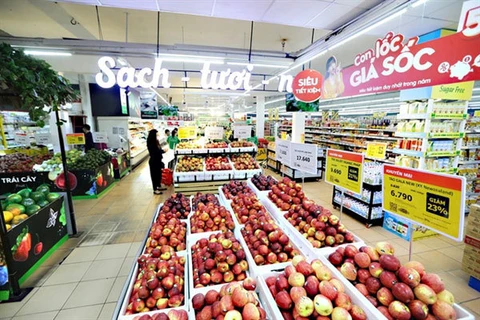Hanoi (VNA) - Though COVID-19 has sent the global economy into one of its worst recessions ever, Vietnam posted GDP growth of 2.91 percent in 2020 thanks to its solid control of outbreaks and timely support to both enterprises and local people.
Like other countries, the pandemic had a devastating impact on the country’s economy and society, with tens of millions of workers affected and business closures at a record high.
Despite the formidable challenges, however, Vietnam has been viewed as a bright spot in the bleak picture that is the global economy. The country was one of the 10 economies with the highest GDP growth in 2020.
The achievements Vietnam has gained at this “unprecedented time” is testament to the resilience of the domestic economy.
Many international institutions spoke highly of Vietnam’s economic growth and its efforts to bring the pandemic under control.
The Government worked throughout the year to carry out the “dual” tasks of preventing the pandemic and maintaining economic growth. Its support policies were an important factor in boosting confidence among local people and businesses and propping up the economy. They include deferring taxes and land rentals, cutting interest rates, and boosting credit and investment.
The country became even stronger and more resilient when the second wave of the coronavirus hit Da Nang city in late July. The Government once again showed its dogged determination to realise the dual tasks and strive for economic growth of between 2.5 and 3 percent.
Relevant ministries, sectors, and localities were ordered to disburse public investment capital faster, while the State Bank of Vietnam was asked to continue its flexible monetary policy to stabilise the macroeconomy and support economic growth.
The Ministry of Industry and Trade joined hands with other ministries, sectors, and localities to identify measures to recover supply chains so as to promote logistics and supporting industry. Furthermore, they worked together to capitalise on signed free trade agreements (FTAs), in particular the EU-Vietnam Free Trade Agreement (EVFTA) and the Comprehensive and Progressive Agreement for Trans-Pacific Partnership (CPTPP).
 Doosan Heavy Industries Vietnam (Doosan Vina) exports three huge desalination devices with a total weight of over 2,000 tonnes to Bahrain. (Photo: VNA)
Doosan Heavy Industries Vietnam (Doosan Vina) exports three huge desalination devices with a total weight of over 2,000 tonnes to Bahrain. (Photo: VNA) Foreign analysts and financial organisations forecast bright prospects for Vietnam’s GDP growth this year. In its latest “Taking Stock” report, the World Bank forecast the Vietnamese economy would grow by about 6.8 percent this year and thereafter stabilise at around 6.5 percent. Meanwhile, the International Monetary Fund (IMF) projected Vietnam to mount a strong recovery in 2021, with growth of 6.5 percent expected.
At the 14th National Assembly’s 10th session, the legislature adopted a Resolution on the socio-economic development plan in 2021, targeting economic growth of 6 percent.
Prime Minister Nguyen Xuan Phuc described the goal as humble compared to the country’s potential, highlighting that the Government is building various growth scenarios and action plans to achieve the best results possible and develop Vietnam into a dynamic economy that posts stable and sustainable growth./.
| In 2020 Vietnam’s GDP grew 2.91 percent, the highest level in the world. The agro-forestry-fisheries sector grew 2.68 percent, industry and construction up 3.98 percent and services 2.34 percent. CPI increased by 3.23 percent. Social investment rose 5.7 percent. FDI inflows were down 25 percent but outbound investment was up 16 percent. New enterprises were down 2.3 percent and businesses suspending operation were up 62.2 percent. Credit grew 10.2 percent. |


























